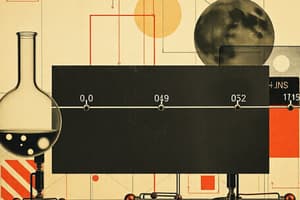Podcast
Questions and Answers
What is the state of a system in chemical equilibrium?
What is the state of a system in chemical equilibrium?
- Products are constantly being formed
- Reactants are used up completely
- Rates of forward and reverse reactions are equal (correct)
- Only the forward reaction is occurring
According to Le Chatelier's principle, if a reactant is added to a system at equilibrium, what will happen to the reaction?
According to Le Chatelier's principle, if a reactant is added to a system at equilibrium, what will happen to the reaction?
- Shift towards the reactants
- No change will occur
- The reaction will stop
- Shift towards the products (correct)
What does the equilibrium constant (K) measure?
What does the equilibrium constant (K) measure?
- Initial concentration of reactants
- Extent of a reaction at equilibrium (correct)
- Final concentration of products
- Amount of energy released in the reaction
How does Le Chatelier's principle help in predicting system behavior?
How does Le Chatelier's principle help in predicting system behavior?
Which factor does not affect the position of chemical equilibrium?
Which factor does not affect the position of chemical equilibrium?
According to Le Chatelier's principle, what effect does raising the temperature have on an equilibrium reaction?
According to Le Chatelier's principle, what effect does raising the temperature have on an equilibrium reaction?
How does a decrease in pressure affect a gaseous reaction at equilibrium?
How does a decrease in pressure affect a gaseous reaction at equilibrium?
What do 'a', 'b', 'c', and 'd' represent in the equation $aA + bB \rightleftharpoons cC + dD$?
What do 'a', 'b', 'c', and 'd' represent in the equation $aA + bB \rightleftharpoons cC + dD$?
Why is understanding chemical equilibrium essential in predicting and controlling reversible reactions?
Why is understanding chemical equilibrium essential in predicting and controlling reversible reactions?
Which principle is crucial for predicting how a system at equilibrium will respond to disturbances?
Which principle is crucial for predicting how a system at equilibrium will respond to disturbances?
How does Le Chatelier's principle describe the response of a system at equilibrium to a change in conditions?
How does Le Chatelier's principle describe the response of a system at equilibrium to a change in conditions?
What happens to a gas mixture at equilibrium if the pressure is increased, according to Le Chatelier's principle?
What happens to a gas mixture at equilibrium if the pressure is increased, according to Le Chatelier's principle?
How does Le Chatelier's principle explain the response of a system at equilibrium when the temperature is raised?
How does Le Chatelier's principle explain the response of a system at equilibrium when the temperature is raised?
If a reactant is added to a system at equilibrium, what will happen to the reaction according to Le Chatelier's principle?
If a reactant is added to a system at equilibrium, what will happen to the reaction according to Le Chatelier's principle?
What happens to the equilibrium position of an endothermic reaction when the temperature is increased?
What happens to the equilibrium position of an endothermic reaction when the temperature is increased?
How does Le Chatelier's principle explain the change in equilibrium constant (K) when a reaction mixture is heated?
How does Le Chatelier's principle explain the change in equilibrium constant (K) when a reaction mixture is heated?
In a gaseous reaction like N2(g) + 3H2(g) ⇌ 2NH3(g), what happens when the pressure is increased?
In a gaseous reaction like N2(g) + 3H2(g) ⇌ 2NH3(g), what happens when the pressure is increased?
What happens to the equilibrium of the acid-base equilibrium H2SO4(aq) + H2O(l) ⇌ H3O+(aq) + HSO4-(aq) when the pH of the solution is increased?
What happens to the equilibrium of the acid-base equilibrium H2SO4(aq) + H2O(l) ⇌ H3O+(aq) + HSO4-(aq) when the pH of the solution is increased?
How does the equilibrium in a redox reaction like Fe2+(aq) + MnO4-(aq) + 4H+(aq) ⇌ Fe3+(aq) + Mn2+(aq) + 2H2O(l) respond to heating the solution?
How does the equilibrium in a redox reaction like Fe2+(aq) + MnO4-(aq) + 4H+(aq) ⇌ Fe3+(aq) + Mn2+(aq) + 2H2O(l) respond to heating the solution?
Why is Le Chatelier's principle considered a fundamental concept in chemistry?
Why is Le Chatelier's principle considered a fundamental concept in chemistry?
Flashcards are hidden until you start studying
Study Notes
Exploring Chemical Equilibrium: Le Chatelier's Principle, Equilibrium Constant, Factors Affecting Equilibrium, and Equilibrium Reactions
Chemical equilibrium, a fascinating concept in chemistry, is the state of a system where the rates of forward and reverse reactions are equal, leading to the constant concentration of reactants and products. In this article, we'll delve into the subtopics of Le Chatelier's principle, equilibrium constant, factors affecting equilibrium, and equilibrium reactions.
Le Chatelier's Principle
Le Chatelier's principle states that if a system at equilibrium is subjected to a change in concentration, temperature, or pressure, the system will adjust itself to counteract the change and restore equilibrium. For instance, if a reactant is added to a system, the reaction will shift towards the products to consume the excess reactant. This principle is a useful tool for predicting how a system will respond to changes.
Equilibrium Constant (K)
The equilibrium constant (K) is a quantitative measure of the extent of a reaction at equilibrium. It is a dimensionless number representing the ratio of the concentrations of products to reactants, each raised to the power of their stoichiometric coefficients. For example, for the reaction A + B ⇌ C + D, the equilibrium constant K is given as:
$$K = \frac{[\text{C}] \times [\text{D}]}{[\text{A}] \times [\text{B}]}$$
Factors Affecting Equilibrium
The position of chemical equilibrium can be affected by various factors:
- Concentration: If the concentration of reactants or products changes, the system will adjust to restore equilibrium.
- Temperature: According to Le Chatelier's principle, raising the temperature will favor the endothermic reaction (releasing energy) while lowering it will favor the exothermic reaction (absorbing energy).
- Pressure: For gaseous reactions, an increase in pressure will favor the side with fewer moles of gas, while a decrease in pressure will favor the side with more moles of gas.
Equilibrium Reactions
A chemical reaction at equilibrium can be represented using a simple equation:
$$a\text{A} + b\text{B} \rightleftharpoons c\text{C} + d\text{D}$$
Here, 'a', 'b', 'c', and 'd' are the stoichiometric coefficients, and the concentrations of the reactants and products are represented by [A], [B], [C], and [D].
Equilibrium Position
The position of equilibrium is independent of the initial concentrations of the reactants and products. This means that the equilibrium concentrations of reactants and products will be the same, regardless of the direction from which equilibrium is approached.
Understanding the concepts of chemical equilibrium is vital for predicting and controlling the outcome of reversible reactions, such as in industrial processes. By knowing the different types of equilibrium and equilibrium constants, we can optimize reactions for desired outcomes and improve the yield of reversible reactions.
In summary, chemical equilibrium is a dynamic process involving forward and reverse reactions that reach a state of constant concentrations. Le Chatelier's principle, equilibrium constant, factors affecting equilibrium, and equilibrium reactions are all critical aspects of this concept. These principles are not only relevant to understanding chemical reactions but also to a broad range of applications in biology, environmental science, and industry.
Studying That Suits You
Use AI to generate personalized quizzes and flashcards to suit your learning preferences.




